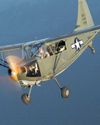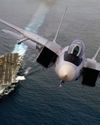Poging GOUD - Vrij
FIRST BRIDGE The start of the Vietnam war
Flight Journal
|January - February 2023
General Curtis E. LeMay, Air Force Chief of Staff, was not happy. First-line U.S. fighters had been in South East Asia in small numbers since 1960. By mid-1964, more fighters began rotating through bases in South Vietnam and Thailand as a show of force. Reconnaissance missions with a pair of fighters as escorts, known as armed recce,” were being flown into Laos and Vietnam, but they were severely restricted in their operations. The fighters escorting the reconnaissance aircraft could attack enemy positions only if they were first fired upon. The politicians were being cautious. By January 1965, there had been several protective reactions,” and even a few fragged planned) missions, but nothing of any real scope. In fact, many of the preplanned missions had failed to find their targets in the confusing jungle landscape or reported disappointing Battle Damage Assessment.

General LeMay, longtime architect and commander of the Strategic Air Command, did not take kindly to less than desirable results on his watch. Exercising his dictatorial powers, he personally selected and fragged a target in Laos. It would be Barrel Roll Mission 9, scheduled for January 12. The target was a small, reinforced wooden bridge, the Ban Ken bridge, over the Nam Mat river roughly 12 kilometers east of the town of Ban Ban, which was located on Route 7 at the eastern edge of the Plain of Jars (Plain de Jares). Route 7 was a major supply route from North Vietnam, turning west at Vinh, crossing the mountains at the Barthelemy Pass, down through the jungle to join Route 4, which was an even larger supply route to Southern Laos, Cambodia, and South Vietnam.

Huns and thuds
The force for this mission would be the largest to date. General LeMay directed that 16 F-105s and four F-100s from Thai bases would join four F-100s based at Da Nang to compose the strike force, and that an RF-101 Voodoo reconnaissance fighter act as a pathfinder to lead the strike force to the target.
In keeping with restrictions in Thailand, the fighters would be loaded with their ordnance and flown to Da Nang for the mission launch. The F-105s, affectionately referred to as Thuds, were each loaded with eight 750-pound Mk117 general purpose bombs or six 750-pound bombs, and two AGM 83 Bullpup missiles. The F-100s would be armed with AGM-83s and CBU-2 cluster bomb weapons to provide flak suppression.
Dit verhaal komt uit de January - February 2023-editie van Flight Journal.
Abonneer u op Magzter GOLD voor toegang tot duizenden zorgvuldig samengestelde premiumverhalen en meer dan 9000 tijdschriften en kranten.
Bent u al abonnee? Aanmelden
MEER VERHALEN VAN Flight Journal

Flight Journal
ELLIPTICAL ELEGANCE
Flying and evaluating the Seafire Mark III
4 mins
November - December 2025

Flight Journal
IRON DOG
Fighting the Pacific and the P-39 at the same time
14 mins
November - December 2025

Flight Journal
Fighter Pilots: A Warrior Clan
TAKE A HARD LOOK at the two young men in these photos. Do they look as if they were bent on killing one another? On the left we have a young, unknown enlisted Japanese pilot standing in front of a Nakajima Ki-27 \"Nate,\" one of Japan's earliest monoplanes that led to the much vaunted Zero.
3 mins
November - December 2025

Flight Journal
KEN WALSH THE FIRST CORSAIR ACE
Medal of Honor pilot's combat adventures
12 mins
November - December 2025

Flight Journal
Big Chief's Little Chief
Thunderbolt action with the Wolf Pack
11 mins
November - December 2025

Flight Journal
ENEMY PILOTS SPEAK Voices from the other side
All too often American students of air warfare forget that enemy aircraftwhether Messerschmitts or MiGs-were flown by human beings with the same motivations and traits as Allied airmen. More often than not, the only difference between friend and foe was the paint on the airplane and where they landed. Therefore, we've assembled a variety of accounts from WW II Axis fighter pilots, men who were more than simply targets.
11 mins
November - December 2025

Flight Journal
FLYING THE FW 190
A legend gets checked out in the Butcher Bird
15 mins
November - December 2025

Flight Journal
DOUBLE-THEATER ACE
The fearless missions of legendary fighter pilot Col. John D. Landers
12 mins
November - December 2025

Flight Journal
WARBUG IN THE PACIFIC
Surviving combat in a Stinson OY-1/L-5
10 mins
September - October 2025

Flight Journal
WINGS OF THE FLEET
Celebrating the U.S. Navy's 250-year legacy
9 mins
September - October 2025
Translate
Change font size

